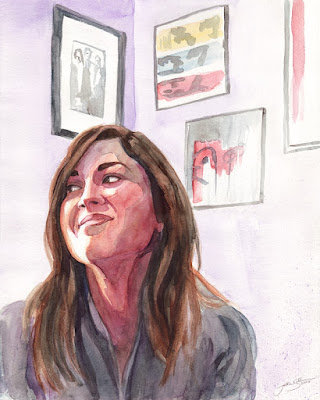Looking at a subject as a series of layers must be pretty familiar by now. Starting out with a general statement about the major shapes in their palest form is the foundation for a painting that will become darker and more specific as you proceed.
Looking at the face, above, can you imagine what the first layer looked like when it was all there was on the page? The remaining lights we see in the finished portrait were originally part of a silhouette shape of the entire head, neck, and sternum. It was a little darker than the white parts of the shirt, and a little lighter than the background.
A layer of middle value warm was laid on top of the pale first layer, covering almost all of it. Only a few lights remain. This new shadow shape is a little darker than the background, but not too dark. There is still room in the range of possible values to make a few slightly darker areas within the shadow, and the darkest darks in the next layer to come. The next darkest layer is the hair, which contains the darkest parts of the painting. Notice, by the way, that the hair is treated as a small number of shapes ranging from white to light, to middle, then dark. It is its own series of layers, observed and presented as a few shapes rather than as a collection of a great many individual strands.
How many layers do you see on the shirt?
Following are a few morw layered portraits, which are followed by a couple of head photos.
For homework, please translate one of the photos into a series of layers, or copy one of the paintings.
Remember, getting the values right is far more important than the colors. For each layer, ask what it is darker than and what it is lighter than.











